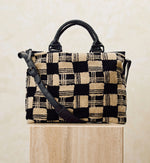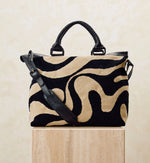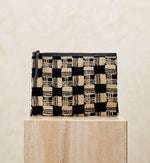
How to Make Your Clothes Last
The Ultimate Guide to Circular Fashion: Caring for Your Garments to Make Them Last
The Future of Fashion is Circular
Fast fashion has long dominated the industry, but a shift toward sustainability is changing how we shop, wear, and care for our clothes. Circular fashion embraces longevity, reusability, and ethical practices to reduce waste and maximize the lifespan of every garment. At Cleobella, we believe in slow, intentional fashion that supports artisans and the planet.
But how can you contribute to the circular fashion movement? By caring for your garments the right way, you can extend their life and keep them looking beautiful for years to come.
In this guide, we’ll explore the core principles of circular fashion and provide expert tips on garment care to help you embrace a more sustainable wardrobe.
What is Circular Fashion?
Circular fashion is a movement focused on designing, producing, and consuming clothing in a way that minimizes waste and maximizes the life of garments. Instead of the traditional linear fashion model (buy, wear, discard), circular fashion promotes a continuous cycle where garments are repaired, repurposed, and ultimately recycled back into the system.
Key Principles of Circular Fashion:
-
Longevity: Creating and purchasing high-quality garments designed to last.
-
Reusability: Passing down or reselling clothing to extend its use.
-
Recycling: Repurposing textiles into new garments or materials.
-
Ethical Sourcing: Choosing natural fibers, responsible production methods, and fair wages.
Cleobella’s commitment to circular fashion means using organic fabrics, artisanal craftsmanship, and timeless designs that defy short-lived trends.
How to Care for Your Clothes to Extend Their Lifespan
One of the best ways to practice circular fashion is by properly caring for your garments. Thoughtful maintenance helps reduce waste and keeps your wardrobe looking effortlessly stylish.
1. Wash Less, Wear More
Overwashing causes unnecessary wear and tear. Instead of washing your clothes after every wear, air them out and spot-clean as needed. This is especially important for natural fibers like organic cotton, linen, and modal.
Pro Tip: Use a fabric refresher spray between washes to keep clothes smelling fresh.
2. Use Cold Water and Gentle Detergents
Hot water can cause fabrics to fade and weaken over time. Wash your clothes in cold water with a gentle, eco-friendly detergent to maintain their color and structure.
Eco Bonus: Cold water washing reduces energy consumption, making it a more sustainable choice.
3. Avoid the Dryer
High heat can shrink and damage delicate fibers. Instead, opt for air drying by laying garments flat or hanging them on a drying rack.
Pro Tip: If you must use a dryer, choose a low-heat setting and add wool dryer balls to reduce drying time.
4. Store Clothes Properly
How you store your garments significantly impacts their longevity. Avoid overcrowded closets, as tightly packed clothes can lead to wrinkles and fiber stress.
Best Practices:
-
Fold heavy knits to prevent stretching.
-
Use padded hangers for delicate fabrics.
-
Store seasonal clothing in breathable garment bags.
5. Repair Instead of Replace
A small tear or missing button shouldn’t mean the end of a garment’s life. Learning basic sewing skills or working with a tailor can help you extend the life of your wardrobe.
DIY Fixes:
-
Use fabric patches to mend small holes.
-
Reinforce seams with a simple stitch.
-
Replace broken zippers or buttons to refresh older pieces.
6. Rotate Your Wardrobe
Give all your clothes equal wear by rotating your wardrobe seasonally. This prevents excessive wear on specific items and allows fabrics to rest between uses.
7. Choose the Right Cleaning Methods for Different Fabrics
Different fabrics require different care. Here’s a quick guide:
-
Organic Cotton & Linen: Wash in cold water and air dry to prevent shrinkage.
-
Modal & Tencel: Use a gentle cycle with mild detergent and avoid harsh wringing.
-
Silk: Hand wash with a delicate soap or dry clean when necessary.
-
Wool: Use a wool-specific detergent and lay flat to dry.
-
Leather & Suede: Spot clean with a damp cloth and condition with a leather balm.
Embracing Circularity Beyond Clothing Care
Caring for your garments is just one part of embracing a circular fashion mindset. Here are a few more ways to integrate sustainability into your wardrobe:
1. Shop Mindfully
Invest in high-quality, timeless pieces rather than trend-driven fast fashion. Cleobella’s collections feature handcrafted garments designed for lasting wear.
2. Resell or Donate
If you no longer wear a piece, consider selling it on secondhand platforms or donating to sustainable organizations to give it a new life.
3. Upcycle Old Clothes
Transform outdated garments into something new! Convert an old dress into a stylish top or repurpose fabric scraps into accessories.
4. Participate in Clothing Swaps
Organize a clothing swap with friends or your local community to refresh your wardrobe without buying new.
5. Recycle Responsibly
When a garment is beyond repair, look for textile recycling programs that repurpose materials into new products.
Fashion for the Future
Adopting circular fashion and caring for your clothes is a powerful way to make your wardrobe more sustainable. By washing less, repairing more, and shopping with intention, you can help reduce waste while enjoying timeless, beautifully crafted pieces.
At Cleobella, we’re proud to create garments that stand the test of time. By incorporating these simple care techniques, you can enjoy your wardrobe for years to come while making a meaningful impact on the planet.
Join the movement—shop consciously, care for your garments, and embrace the beauty of circular fashion.












